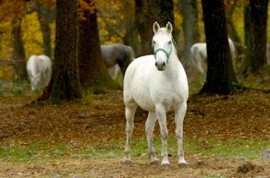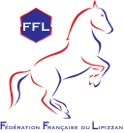

Vous êtes ici : Accueil > Actualités > Actualités Elevage > Actualité élevage (suite)
actualités élevage (suite)

_files/shapeimage_2_link_0.png)
_files/shapeimage_2_link_1.png)
_files/shapeimage_2_link_2.png)
_files/shapeimage_2_link_3.png)
_files/shapeimage_2_link_4.png)
_files/shapeimage_2_link_5.png)
_files/shapeimage_2_link_6.png)



The Inco-Copernicus project commenced after top level discussions in Lipica in 1996.
It is financed bythe European Commission together with:
*The University of Vienna under Professor Brem.
*The University of Ljubljana under Professor Habe.
*The University of Budapest under Professor Bodo.
*The Lipizzan International Federation (LIF).
The aim of the Project is to present a scientifically based description of the phenotypic and genetic structure of the Lipizzan Horse and to recommend the implementation of the results of the Project in future breeding programmes.
The scientific goals are to map the genetic structures of the Lipizzan Breed using
*DNA markers
*Blood groups
*Polymorphic systems
*Morphologic parameters
*Measurements
*Photographs
*Pedigree data (analysis of inbreeding)
*Health status
*Performance parameters (including reproduction)
During 1996, the first working year of the Project, the Stud Farms of Piber, Lipica, Topolcianky, Simbata de Jos, Beclean, Szilvasvarad and Djakovo were visited by the project team. Blood samples were taken from all Lipizzan horses. They were also measured and photographs were taken to aid in the evaluation of the breed. In the first half of 1998 the Italian Stud farm of Monterotondo was visited and their Lipizzan Horses were evaluated.
The number of Lipizzan Horses analysed by the Project Team were as follows:
*Piber & the Spanish Riding School – 153 Lipizzans
*Lipica – 69 Lipizzans
*Topolcianky – 42 Lipizzans
*Simbata de Jos- 90 Lipizzans
*Beclean – 28 Lipizzans
*Szilvasvarad – 77 Lipizzans
*Djakovo – 64 Lipizzans
*Monterotondo – 63 Lipizzans
The total number of Lipizzan Horses evaluated was 586 breeding animals. Beside this number, 66 Kladrubers were included in the programme from Kladruby and Slatinany.
Role Of The L.I.F.
The LIF has the responsibility of collecting pedigree data of stallion lines and mare families.
It has also provided a detailed history of the breed to assist the Project through its analysis of the development of the Lipizzan. The LIF is also in charge of publishing data and dissemination of the results of data collected.
The European Commission
EC protection of the breed has been given because the Lipizzan Horse is a Paneuropean breed and is part of the heritage of Europe. The Lipizzan numbers are such that a controlled breeding plan is vital if the breed is to prosper for future generations. Our President. Rudolf Leiner is largely responsible for bringing the importance of the Lipizzan to Europe's heritage to the attention of the European Commission and he has worked tirelessly to achieve the success he has had in this.
The data is at present being analysed and Professor Habe has already found one surprising result during his research. The actual degree of inbreeding amongst the overall Lipizzan herd is less than previously thought. Dr Merkens is at present dealing with the possibility of Lipizzans from private breeding herds being included in the concluding presentation of the Copernicus Project.
Further developments, findings, analysis and the eventual conclusion of this major scientific project for the protection of the future of this important European breed will be posted in these pages.

